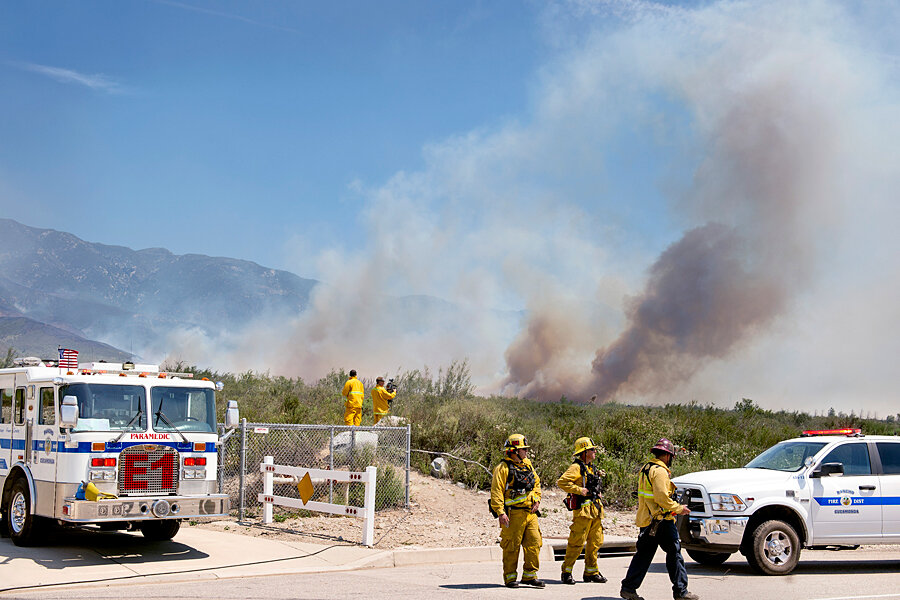Early California wildfire sparks concerns even as firefighters hold the line
Loading...
| Los Angeles
With more than 700 firefighters battling flames in the southern California community of Rancho Cucamonga, officials say the flames are at least 10 percent contained and no new acreage is burning. The fire has consumed some 1,000 acres so far.
However, while the firefighters are holding the line, officials point out that this first significant fire of the season – which has ignited far earlier than in normal years – is an indicator of the fire season to come, with implications for the rest of the nation.
“At this point, California is an area of high concern because of drought conditions for such a long time,” says Randy Eardley, spokesman for the National Interagency Fire Center in Boise, Idaho.
For the past decade, he notes, the fire season in California has been starting earlier and earlier, “and now it is ripe for more fires.”
Local officials are quick to point out that there have been no structures lost to this current fire and there have been only extremely minor injuries to firefighters, such as eye irritation from flying dust and debris. They also note that they anticipated such outbreaks and prepared for them.
“We had people and equipment pre-positioned down here since Tuesday ready for something like this,” says Brian Grant, public information officer for the US Forest Service out of the San Bernardino National Forest.
Local residents were under mandatory evacuation orders on Wednesday, but as of Thursday all evacuations were voluntary. Officials are stressing that homeowners need to be cautious as they move around their community, Mr. Grant says.
“We have firefighters roaming the neighborhoods, checking between houses,” he says, checking for embers or flammable materials. The cause of the fire is under investigation by the local, state, and federal agencies that have come together to battle this early event.
Sources of ignition are of particular importance in dry years, officials note. Extreme and even exceptional drought continues throughout nearly all of California, and this is likely to lead to an above average year for fires, says Chris Williams, professor at Clark University in Worcester, Mass.
“Vegetation stressed by drought is more flammable because of low moisture content. Severe, prolonged drought also leads to plant mortality and increased litterfall in some instances, which can increase fuel loads overall,” he adds via e-mail.
Adding to the risk factors, low snowpack and dry soils can be expected to bring about an earlier start to the fire season as well, points out Professor Williams. While widespread, heavy precipitation in late February brought much needed moisture to the region, which supported a pulse of vegetation growth, he says, “The rains were not enough to alleviate the longer term potential for a high fire year.”
Experts suggest that an early fire threat could help bring attention to the issues facing different regions of the nation. The risk of drought and large fires is ever-present across the Southwest, including much of California, Williams says, “however, the present condition really stands out compared to long-term records.”
Overall changes in the climate also impact the uptick in fires, says Robert Dull, senior research fellow in the Environmental Science Institute at The University of Texas at Austin.
“Rising global temperatures also have played a role by increasing evaporation from soils in wildland forest and chaparral ecosystems,” he says via e-mail.
The Santa Ana winds are particularly adept at facilitating rapid spread of the southern California fires, he adds. Indeed, firefighters in Rancho Cucamonga were restricted to fighting on the ground because the high winds made aircraft deployment impossible.
Professor Dull points out that these are not solely California issues. The six worst fire years in the past half century, in terms of total acreage burned in the United States, have occurred in the past 10 years, he notes. “This means that fires are occurring with greater frequency in California, but also more broadly throughout the western United States,” he adds.
Fire historian Stephen Pyne, a professor at Arizona State University in Phoenix, suggests that while it is too early to know just how serious this fire season will be, he is hopeful that one side effect of an early spotlight on fire will contribute to forging a more comprehensive national fire policy.
“On the one hand, we have the Feds who have a mandate to manage the land, and they need fire. Then you have the states, and they just want fires to go away, and then there are the urban folks who don’t want fire of any kind,” he says.
And yet they are all members of a common community, he points out, “and they face a common threat. It would be very useful to come together and get some kind of consensus about what to do.”





